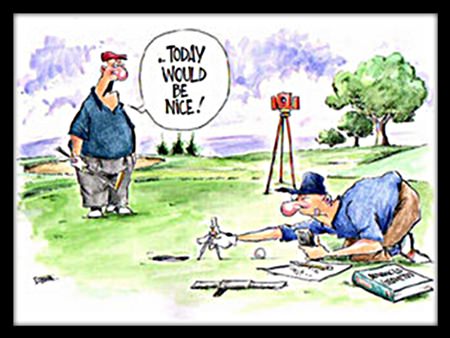Last week’s article looked at the curse of slow play on the PGA Tour, the culprits, and what is being done about it – which is basically nothing. Let’s now turn our attention to the pace of play, here in Pattaya.
Pattaya golf is different for many reasons. We sometimes play behind five and six-balls, we host both competition and non-competition golf, our golfers represent many nationalities and cultures, and many of us use Pattaya as our introduction to the game. Given there is no single entity overseeing golf in Pattaya, it’s no wonder we struggle to have all golfers play at a similar pace. But try we must.
 Slow play – killing other’s enjoyment.
Slow play – killing other’s enjoyment.
First up, let’s deal with what I hear many Farang complain about; Thai or Korean five or six-balls. The number of times this actually happens is minimal. And when it does, they are often faster than some Farang four-balls. It is not a huge cause of frustration, nor is it something we can do anything about. In short, it’s not worth worrying about.
Second, if it wasn’t for the Koreans and Japanese arriving in huge numbers in high-season, and spending what they do, many courses would be forced to close as the Farang spend wouldn’t be sufficient to keep them open. Think of that the next time you encounter a Korean five-ball.
What we can do something about is the biggest cause of slow play; a minority of golfers that exist in nearly every golf society that invariably hold up play. These are the Furyks and the Nas of the amateur game here in Pattaya. These are the ignorant and the not-so-ignorant who don’t give a monkey’s. These are the real culprits. It is they who should be encouraged to change their ways.
I refer to those golfers whose habits include one or more of the following:
- Not being ready to actually “pull the trigger” when it’s their turn.
- Taking an inordinate time to complete a pre-shot routine.
- Not preparing during delays, e.g. determining distance, wind, type of shot etc.
- Not taking a selection of clubs after approach shots – insists on waiting for the caddie.
- Not determining their line of putt until it’s their turn.
- Insist on marking their ball after every missed putt, including those less than two feet.
We should be tolerant of those new to the game who don’t know they are slow, who are not aware of the ways to speed up play. It should fall to any experienced golfer in the group, no matter their handicap, to inform the ignorant of the error of their ways. Whether this is done after the round over a beer or during the course of play is a judgement call.
As for the experienced golfer who knows they are slow, but refuses to change their ways, they risk alienation. These golfers need to realise their habits will be tolerated, but only up to a limit. That limit is reached when their pace of play adversely affects the play of their playing partners, as well as those following. If it continues, then the offending golfer should be suspended for whatever time it takes for him/her to change their ways. No golfer, no matter how well regarded off the course, has the right to impose himself on playing partners in such a manner.
Rounds of golf in Pattaya are rarely medal rounds. They should take on average no more than four-and-a-half hours – with or without carts. Notwithstanding, with the best will in the world, any four-ball can lose ground. All it takes is a lost ball or two and the gap in front soon becomes a full hole, especially if the trouble occurs on a par-three.
Having lost ground to the field, what can a four-ball do to pick up its pace? The trick here is to recommend actions that do not impact on existing pre-shot routines, so it’s not a big deal, not yet. This is phase one. Phase two, changing someone’s bad, time-consuming habits, is best done over a beer.
- If playing stableford, have players pick-up when their score on any one hole exceeds net one-over-par. At this point their stableford score for that hole will be zero.
- Introduce “ready golf”; a common term used to encourage whoever is ready to go ahead and play their shot, whether it’s their turn or not.
- As soon as the first player putts out, have them proceed to the next hole and tee off, immediately. Some players may regard this action – of leaving the green before a player has putted out – as impolite. I assure any reader, the act of continually holding up the four-ball behind is a far greater breach of etiquette than leaving a green “early.”
- Encourage players not to mark their cards when it’s their honour. Have them tee-off first.
- While waiting on the tee, or at any point through the green, work out what club you are going to play, and how. When it comes to your turn, you should be good to go. To those who use distance measuring devices, don’t wait until the green is clear before taking your measurement. Pick on another target to give you the info required. You need the exact yardage? Really – you are that good? Yeah right!
- If you need to read your putt from the other side of the hole, do so while waiting your turn.
- Pay attention to the line of tee shots, not just your own.
- If doubt exists over whether a ball is in play, or may be difficult to find, always play a provisional ball. Please note, if your ball is believed to be in a hazard, the Rules do not permit the playing of a provisional ball. If you’re playing with a PSC group, however, your Local Rules state you must play a provisional ball, regardless.
- If carting on a day when they are restricted to cart paths, please, please take more than one club with you when unsure of your lie or distance.
- People sharing golf carts should use them as a way to play faster, not as a way to be lazy and selfish. If four guys are playing in two carts, it is not necessary to drive to everyone’s ball. The player playing second can grab a few clubs and walk rather than wait.
Appreciate that the new golfer in your group may never have received tuition on pace of play. If this appears the case, then it is beholden upon the experienced golfer to pass on appropriate guidance.
One great tip for saving time on putting greens – watch Rory McIlroy the next time he is on TV and copy his putting routine, his practise putting stroke in particular.
If this slow-play message applies to you, or perhaps to one of your regular playing partners, have them read this article in the hope it may change their behaviour. C’mon you slow golfers, plea se change – the rest of us have had a gutsful!
Golfnutter




